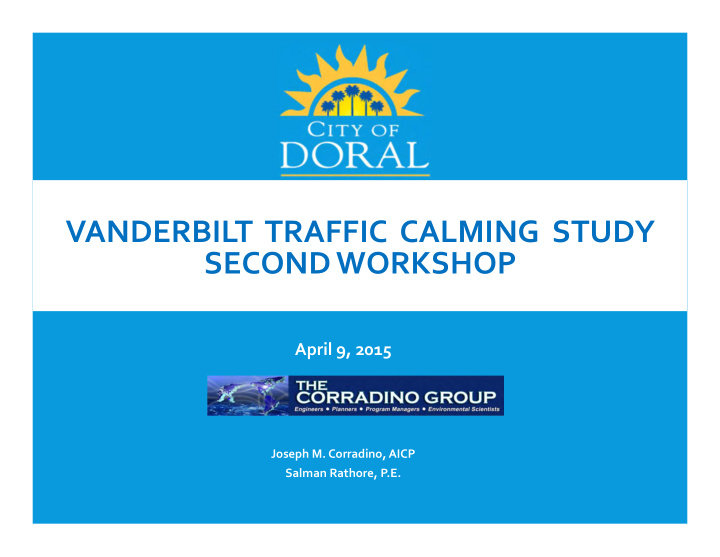



VANDERBILT TRAFFIC CALMING STUDY SECOND WORKSHOP April 9, 2015 Joseph M. Corradino, AICP Salman Rathore, P.E.
TRAFFIC CALMING
TODAY • Introduction • Define • Good Planning • Purpose and Need for Study • Discussion • Data Collection Analysis • The Results • Traffic Improvement Plan • Next Steps
DEFINITION Traffic Calming Changes in the street, through physical or psychological means to reduce traffic speeds or cut ‐ through volumes in order to achieve a higher quality of life for the residents and community as a whole.
GOOD PLANNING • Understand the neighborhood • the issues • the problem • Educate, Engineer, Enforce • Identifying the nature and extent of traffic related problems on a given street or in given area • Selecting and implementing measures for solving identified problems • Moving gradually to more intensive measures (Least intrusive to most intrusive) • SOLVE the Problem, Not MOVE the Problem
PURPOSE AND NEED FOR STUDY
DATA COLLECTION ANALYSIS SSIVE TO ACTIVE The objective of the data analysis was to identify the need and locations for traffic calming improvements within the study area. These improvements are determined: • to assess the existing traffic conditions in the study area • to determine if livability thresholds for residential neighborhood streets are being exceeded, and • to determine if speed thresholds for residential neighborhood streets are being exceeded
DATA COLLECTION LOCATIONS SSIVE
LIVABILITY THRESHOLD SIVE TO ACTIVE Livability Threshold • The Miami ‐ Dade County Traffic Flow Modification(s)/Street Closure(s) Procedure (Revised January 2009) provides guidelines for when the livability of residential streets is compromised. o For residential local streets, traffic volumes should not exceed 1,050 vehicles per day or 105 vehicles in the peak hour.
LIVABILITY THRESHOLD MAP
SPEED THRESHOLD Speed Threshold • The purpose of collecting speed measurements was to determine the magnitude of vehicle speeds within the neighborhood. o For municipalities with traffic calming funding, 85th percentile speeds exceeding the posted speed limit by 5 mph or more are considered to have an excessive speeding issue.
SPEED THRESHOLD MAP
TRAFFIC IMPROVEMENT PLAN (PHASE 1) ACTIVE PHASE 1 NW 102 nd Avenue (See detail A) – Chevron pavement marking, “Do Not Enter Sign,” “No Outlet Sign” and “Left Only Sign” to be placed to restrict NB traffic from the intersection of NW 25 th St and NW 102 nd Ave to enter residential streets without compromising connectivity of commercial businesses at intersection of NW 97 th Ave/NW 25 th St.
TRAFFIC IMPROVEMENT PLAN (PHASE 1) ACTIVE PHASE 1 Right turn restriction signs at NW 97 th Avenue for NW 28 th Terrace, NW 27 th Terrace & NW 27 th Street.
TRAFFIC IMPROVEMENT PLAN (PHASE 1) ACTIVE PHASE 1 Replace the posted speed limit from 30 mph to 25 mph on NW 27 th Terrace. Place 25 mph speed limit signs at multiple locations as indicated in the Traffic Improvement Plan Figure.
TRAFFIC IMPROVEMENT PLAN (PHASE 2) ACTIVE PHASE 2 NW 102 nd Avenue (See detail A) – Raised Island to be constructed to restrict NB traffic from the intersection of NW 25 th Street and NW 102 nd Avenue from entering the residential streets.
TRAFFIC IMPROVEMENT PLAN (PHASE 2) ACTIVE PHASE 2 Traffic circles to be constructed at the intersections of NW 28 th Terrace and NW 99 th Avenue and NW 27 th Street and NW 99 th Avenue.
TRAFFIC IMPROVEMENT PLAN (PHASE 2) ACTIVE PHASE 2 Speed tables to be provided at multiple locations as indicated in the Traffic Improvement Plan Figure.
TRAFFIC IMPROVEMENT PLAN (PHASE 2) ACTIVE PHASE 2 Splitter Island to be constructed at 102 nd Avenue between NW 27 th Street and NW 27 th Terrace.
TRAFFIC IMPROVEMENT PLAN (PHASE 2) ACTIVE PHASE 2 A study is recommended to determine if all way stop signs is warranted at the intersection of NW 26 th Street and NW 99 th Avenue. Based on the warrant analysis results, 4-way stops may be recommended at this location.
SPEED TABLES
SPLITTER ISLAND
TRAFFIC CIRCLES
NEXT STEPS ACTIVE Phase I • Plans will be provided to Police, Fire Department and Solid Waste for review and approval • City will mail out ballots to the entireVanderbilt Community • City will need 2/3 of the ballots agreeing with the implementation of recommendations • 100% consensus from adjacent property owners is required prior to implementation of traffic circles, speed tables and splitter island • City will post results on the City’s website and mail the community the results • If votes are in favor, Phase I improvements will be implemented Phase II • If votes are in favor, Phase II improvements will be designed, permitted and constructed
QUESTIONS / COMMENTS? For further information or comments contact: City of Doral Public Works Department 8401 NW 53rd Terrace, 2nd Floor Doral, FL 33166 (305) 593 ‐ 6740 Publicworks@cityofdoral.com Thank You!!
Recommend
More recommend